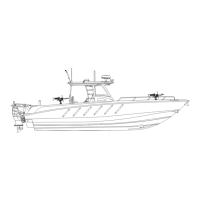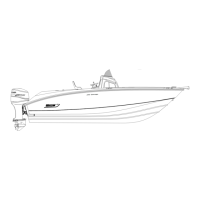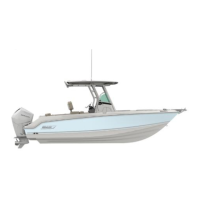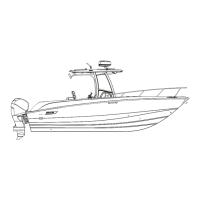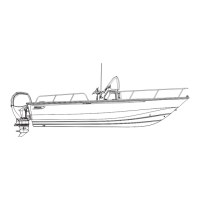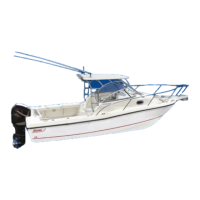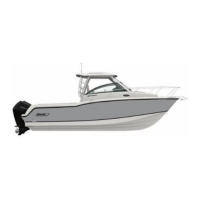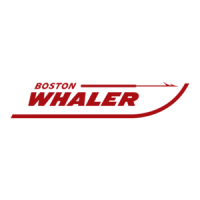
Do you have a question about the Boston Whaler 20 Justice Series and is the answer not in the manual?
| Brand | Boston Whaler |
|---|---|
| Model | 20 Justice Series |
| Category | Boat |
| Language | English |
Guidance for safe operation and adherence to manual instructions and regulations.
Information on assisting distressed boaters under the 'Good Samaritan' rule.
Details on PFD types, accessibility, and proper usage for crew safety.
Hazards of carbon monoxide and precautions for engine exhaust exposure.
Information on boat fire extinguishers, their types, and proper use.
Guidance on marine fire response, from small fires to potential explosions.
Safety precautions for operating the boat in adverse weather conditions.
Emergency Position Indicating Radio Beacon system operation and maintenance.
Understanding and adhering to the boat's maximum capacity limits for safety.
Causes and actions to take in the event of a boat capsizing scenario.
Factors leading to boat swamping and recommended preventative measures.
Operating procedures and safety warnings for the dive/rescue door.
California-specific warnings about chemicals in boat components and potential health risks.
Identification and location of various warning labels on the boat.
Essential checklist for ensuring the boat is ready and safe before starting any mission.
Function, operation, and safety precautions for the engine ignition shutoff switch.
Operation of the key switch for starting, running, and stopping the outboard engine.
Emergency system to connect batteries for starting assistance during low voltage.
Step-by-step guide for safely starting the outboard engine.
Operation of the single-lever control for gear selection, speed, and trim.
Adjusting engine trim angle for optimal performance, fuel economy, and ride comfort.
Overview of dashboard gauges monitoring engine systems like RPM, fuel, and water pressure.
Displays engine speed in revolutions per minute (RPM) for performance monitoring.
Records cumulative hours of engine operation for maintenance scheduling.
Indicates the approximate fuel level in the boat's fuel tank.
Monitors the engine's cooling system pressure, indicating its condition.
Displays engine battery voltage, indicating the health of the charging system.
Measures the engine's angle position relative to the transom for optimal trim.
Boat and engine information system for monitoring various operational parameters.
Information on propeller selection, maintenance, and impact on boat performance.
Techniques and considerations for skillful boat handling in various conditions.
Guidelines for proper placement of loads to ensure boat performance and safety.
Operation and adjustment of electro-mechanical trim tabs for boat attitude control.
Checklist for properly securing the boat systems after a mission.
Guidelines for safely towing the boat on a trailer.
Experience and skill requirements for towing a boat, including safety guidelines.
Safety warnings and procedures for lifting and slinging the boat.
Use of factory-installed gunwale lifting eyes for safe boat lifting.
Overview of the boat's built-in gasoline fuel system, tank, and components.
Visual representation of the fuel tank, fill, vent, and withdrawal system components.
Details on the Racor fuel filter, its function, and replacement schedule.
How the fuel level sending unit and gauge work together to display fuel status.
Identification of the fuel fill cap and fuel tank vent locations on the boat.
Purpose and components of the boat's bonding system for electrical safety.
Critical safety warnings and guidelines for refueling the boat.
Precautions to prevent static discharge during fueling operations.
Important procedures and safety measures to follow during fueling.
Step-by-step instructions for removing and installing the fuel fill hose.
Instructions for replacing the fuel tank vent hose and associated components.
Effects of contaminated fuel on the boat's systems and recommended actions.
Information and precautions for using ethanol-blended gasoline (E-10) in the boat.
Identification and placement of controls and instruments on the helm console.
Diagram showing the arrangement of features and components on the boat's deck.
Operation and components of the hydraulic steering system for boat control.
How to steer the boat when moving forward using the steering wheel.
Steering the boat while backing up, noting reduced effectiveness.
Operation and importance of navigation lights for safety and visibility.
Functionality, control, and maintenance of the boat's bilge pump system.
Operation and adjustment of trim tabs to control boat attitude and performance.
Using trim tabs and engine trim to achieve optimal planing and running attitude.
Understanding magnetic compass operation, deviation, and variation.
Emergency system to connect batteries for starting assistance during low voltage.
Use and operation of the interior console dome light.
Operation of red cockpit lights for night visibility without glare.
System components and procedures for towing another boat.
Guidelines and safety checks for towing another vessel.
Proper use and securing of the swimmer's ladder and boarding platform.
Overview of the boat's 12 VDC electrical system, power sources, and wiring standards.
Safety warnings and essential precautions for handling and servicing boat batteries.
How the outboard engine and AC charger maintain battery charge, including isolator function.
Explanation of grounding and bonding systems for electrical safety and corrosion control.
Operation and function of battery switches for power distribution and isolation.
Overview of the six main 12 VDC power distribution circuits and their components.
Power circuit for the helm station switch panel and its connected accessories.
Power circuit for the accessory fuse block, supplying various boat accessories.
Power circuit for electronics and accessories mounted on the T-top.
Detailed breakdown of DC circuits powering helm, bilge pump, and accessory panels.
Reference guide for identifying wire colors and their corresponding electrical functions.
Key physical and performance specifications for the boat model.
Importance and location of the Hull Identification Number (HIN) for boat identification.
Regular maintenance procedures to preserve the boat's hull and appearance.
Guidelines for washing the exterior and interior of the boat using appropriate methods.
Recommendations for waxing fiberglass surfaces to protect the gelcoat.
Procedures for repairing typical hull damage like cracks, gouges, and chips.
Inspection and maintenance of cutwater and transom corner chafe plates.
Understanding hull blistering, its causes, and preventative measures.
Important steps for storing the boat to prevent hull blistering.
Process of bottom painting to slow hydrolysis and control marine growth.
Maintenance of the fuel tank and associated hoses and fittings.
Routine checks and maintenance for the manual hydraulic steering system.
Safety warnings and precautions for handling and servicing boat batteries.
Maintenance checks for the bilge pump and water level switch.
Periodic checks on trim tab actuators and anode replacement.
Preparation procedures for the boat and engine for long periods of non-use.
Steps to protect the fuel system and engine from moisture and temperature changes during storage.
Ensuring proper hull drainage and securing the drain plug for storage.

